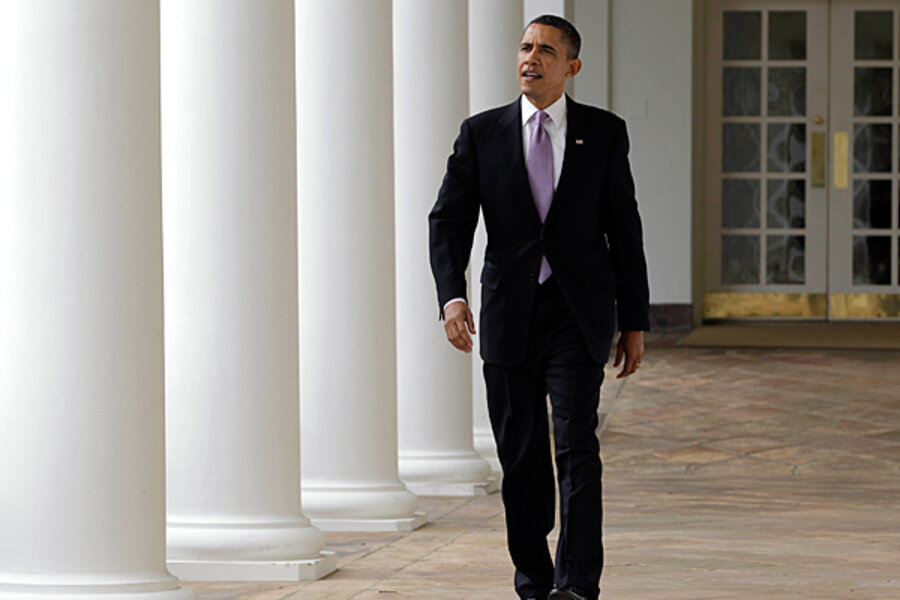State of the Union address: Do Americans even watch it?
Loading...
| Los Angeles
Officially, the annual State of the Union speech is for the president to address members of Congress, the representatives of the people.
Of course, radio and TV has allowed the president to take his message directly into American homes for the better part of the past century. Now, in today’s restless, hypermedia age – in which the Internet and mobile devices enable viewers to snack their way through the news – his audience has gone virally global, increasing the strategic burden on the president but also expanding his opportunity to communicate with a vast and diverse “constituency.”
So who actually tunes into this annual political rite?
How much do you know about the State of the Union speeches? A quiz.
Usually, about 45 million to 50 million people watch it the traditional way: on TV. That number can vary, though, from year to year, according to Nielsen ratings. Bill Clinton set a recent high-water mark of nearly 67 million households in 1993, but he also defined the lowest ebb in 2000 with less than half that.
Sure to be among them are the “political junkies,” says Binghamton University political scientist John McNulty. These include the slew of policy wonks hovering blocks from Capitol Hill, as well as foreign leaders in virtually every country on the planet scouring for hints about new policy directions.
This vast and often conflicting cornucopia of politically motivated tune-ins makes the president’s job a strategic balancing act. The audience comes from many urgent points of view around the world – with the most important being in the US, says Bruce Newman, editor in chief of the Journal of Political Marketing at DePaul University in Chicago.
The list includes Democratic and Republican Party officials in every state and city. Potential donors for the 2012 presidential run will also be observing closely, adds Mr. Newman via e-mail, adding that this means “Interest Groups, Political Action Committees, and generally wealthy people, corporations, and individual voters.”
Niche groups and a worldwide audience
Interest groups such as the global warming skeptics behind junkscience.com, for instance, will be tuning in to see if the president addresses their particular niche of concern. “Everyone interested in global warming and the green energy movement will be tuning in to see what Obama has to say,” says junkscience.com publisher, Steve Milloy, adding that a mention in such an important policy speech as the State of the Union could give an important hint about an administration's future plans in a given area. “Anyone with an issue to follow will be listening very closely,” he adds.
This worldwide audience also includes an avalanche of media, says Iowa State University political scientist Steffen Schmidt, noting that members of the press from every conceivable outlet “will boil down and pass on his message downstream in print, on the Internet, TV, radio, blogs, Tweets," he says via e-mail. “So it’s very important for him to connect with that audience.”
The people who actually watch the whole speech will be minimal relative to how the speech is reported by this media onslaught, agrees Newman.
“Exactly which parts of his speech are repeated in media clips become very important parts of his strategic objectives, something his marketing people will not know until after the speech is given,” he says.
“In a democracy, it becomes very difficult to ensure which words/messages are picked up by the people. This makes the communication strategy for the president a much more difficult marketing challenge than it would be for a corporation like Apple advertising its newest hi-tech consumer device,” Newman adds.
Declining interest in politics
Beyond the circles of those with a horse in the race, the primary audience among the general population will be those who agree with the president, says Fordham University presidential scholar Jeffrey Cohen, author of "The Presidency in the Era of 24-Hour News." The number who tune in to be good, well-informed citizens is declining, he notes, primarily because “very few people in the general population give a hoot about politics.”
This is especially true on many college campuses, says Jeff McCall, communications professor from DePauw University, in Greencastle, Ind.
“Very few college kids tune in to see prime time presidential addresses, regardless of who is in the White House,” he writes in an e-mail. Due to the tradition and pomp surrounding it, he adds, the State of the Union draws an audience that goes beyond political junkies, “but not that much.”
“The State of the Union address benefits from being on all four major broadcast channels, plus the cable news outlets, etc. Thus, a lot of people stumble into watching as they just turn on the television while settling into their comfy chair for the evening,” says Mr. McCall.
The shootings in Tucson have galvanized interest in national politics to a certain degree, adds Mr. Cohen. And of course, he says, there will always be people who will tune in just on the off chance that an unexpected gaffe or interruption turns the evening into good-old-fashioned entertainment.
How much do you know about the State of the Union speeches? A quiz.





